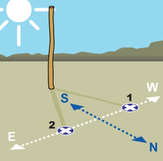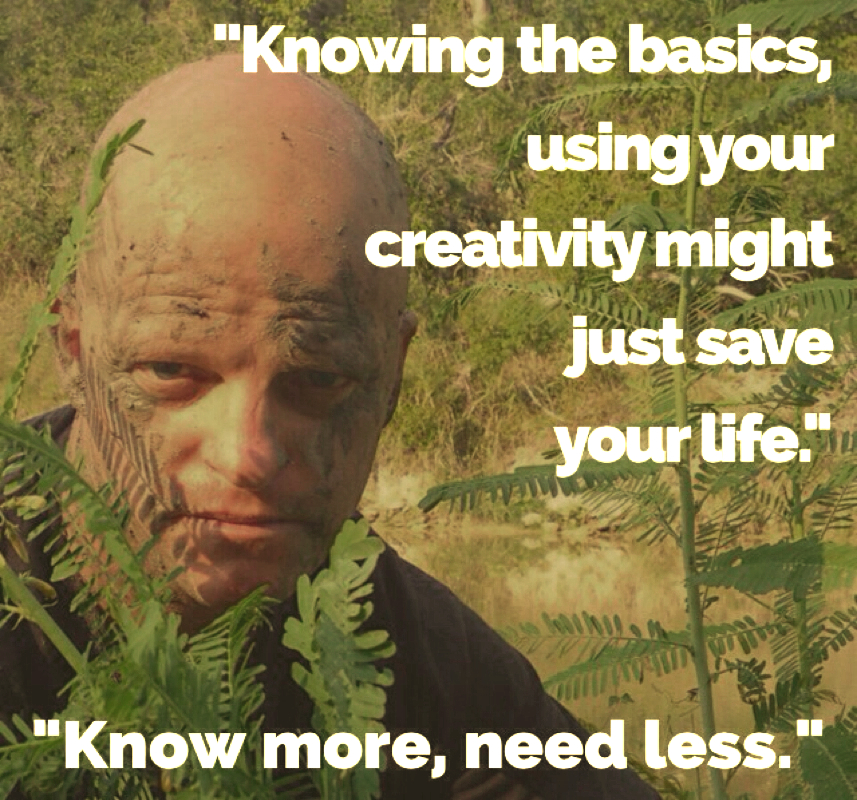Dan Shrigley's Desert Survival Tips29/11/2014  www.DanielShrigley.com www.DanielShrigley.com #DanShrigley #Desert #Survival #Tips: Water is a life or death commodity in the desert. I always suggest you bring 3 X's the daily amount in extreme heat typically 1 Gallon US Standard per person per day. (Prevention is planning, followed by action and revision) Should you find yourself lost, stranded or stuck in a desert survival situation you will need Water, Shelter and Fire to survive. Water takes main stage in this theater of survival. First you must conquer fear which I have talked about many times in my writings and on radio. The psychology of survival and how to defeat fear is your first challenge. It's critical to remain calm and collect your thoughts or you may die in any survival situation. The feeling of despair, hopelessness is very real but you can overcome it with the right mind set. Once you calm down you need to meditate on your surroundings. Identify what is available to you. At this critical moment where everything that you see could possibly become a tool for your survival. Allow for your creative imagination to render positive impact on potential tool construction using primitive technology known as bushcraft. In almost every survival scenario a forked Walking stick is one of the most important tools you should pick up first. It needs to be one or two feet taller than your height. Reason being stick in hand with arms extended this gives you plenty of standoff from poisonous snakes, and coyotes. The forked stick with a v-cut will help pin down a snake at the head. My first recommendation is do not mess with the wildlife. You can live for 2 to 3 weeks without eating food, you can only live for 1.5 to 3 days without water depending on the conditions of your environment. Your second most valuable tool in a desert environment is a container or capture device to collect water. This will allow you to transport water or travel with water as you try to achieve self rescue. Your third most viable tool will be a device that you can dig with if needed to procure a water source of its water. Sometimes in dry desert locations your best places to seek water are plants, springs, and the bottom of cliffs with limited sun exposure for soil extraction. When I was serving in the Army, and we were in Kuwait the temperatures would reach 115°F to 150°F depending a lot on materials that surrounded us, such as blacktop roads, concrete barriers or even vehicles. Typically the US Army encouraged us to drink water and drink a plethora of it. One skill we used to cool our core temperature was to wet our clothing and wet a hanker chief. Tied around our necks to cool blood flow through our jugular veins. This assisted with cooling our core temperature. BIRDS & WILDLIFE: Birds, animals and insects offer great indicators based on their behavior where water sources might be found. (Especially as for insects are concerned look for nats, flies and mosquitoes). Birds will tend to circle in the air above water sources. Boil or treat all water before drinking. Remember when drinking water from a pond, pool, river, creek or stream that animals visit you must treat the water. Reason, due to the fact that animals have poor hygienic practices. DRY RIVER or CREEK BEDS: Dry river or creek beds with vegetation are great places to dig for water. You may need to take into consideration the terrain. Find the lowest point of elevation. Even if all you find is damp soil you can use clothing to press droplets out. Suck the moisture, repeat the process as needed. Water sources are a great place to find edible plants for food, but beware that near water grows poisonous plants and you need to know exactly what you are eating. Flip rocks over in creek beds or riverbeds to locate water. Water tends to get trapped under rocks and evaporation is drastically slowed under the surface of the rocks. Water is protected from exposure to the sun under rocks. Additionally water tends to collect at the base or bottom of cliffs especially in the face of the cliff that gets the least amount of sunlight as mentioned above. Morning dew collects on plants and rocks, use a T-shirt or sock to soak up water. Suck on or wring out into your container or capture device collected water. In a survival situation every single drop of water is gold. Water is not to be wasted, this is a matter of your life or death. Without water you will most certainly die in an extreme climate situation such as the desert environment. TREES: Cottonwoods, willows, sycamores, huckleberry and cottontails generally are near groundwater. So if you see one, two or three trees off in the distance that might be a great indicator that there is a water source feeding those trees. (So know how to identify these trees on sight) CACTI: Cacti are a good source of water. The Prickley Pear offers an edible food source and moisture and you can eat the fruit or the leaflet to self sustain and collect water moisture. (BEWARE!!!) Beware of cacti that consists of a white milky colored liquid. Some cactus are highly poisonous do not drink or eat any cactus fluid that contains a white milky substance. TRAVELING: It is always best to travel in the times that the days are the coolest and you still have visible light. Sunrise and sunset are great times to travel in the desert. Most desert critters are nocturnal. Snakes tend to come out at night as well as coyotes, cougars or mountain lions. To avoid injury try to refrain from traveling during daylight peak hours when the sun is at its highest point in the sky. Avoid hiking at night to avoid trips and falls and potential injuries. Dark crackled mud with a tendency to curl up at the edges, but a look or feel of chocolate might be an indicator of a potential water source. Remember when traveling in the desert; Terrain features are often 5 to 10 times farther away than they appear. Before making your trek be certain you have enough water on hand to sustain yourself until you get to your destination. Always seek water while traveling on route to your destination. This article was written by Daniel W. Shrigley otherwise known as America's Survival Son. www.facebook.com/Daniel.Shrigley.Survival  Shadow Stick Method Shadow Stick Method Survival Tip: Shadow Stick Method In an open area, place a stick 12" inches in length securely in the ground. Standing straight and then grab two rocks. Look for the tip of the casted shadow. Mark the first position with one rock at the tip of the shadow. Wait for 15 minutes then mark the tip of the shadow with your 2nd rock. From the base of the stick draw a line center between the two rocks. You now know which direction north is in the Northern Hemisphere. www.IMDb.me/Daniel.W.Shrigley #SurvivalTips brought to you by America's Survival Son #DanShrigley STINGING NETTLES - Survival Food28/11/2014 STINGINIG NETTLES:
The stinging nettle is a great source of vitamin A and C; it also contains manganese and potassium. You can collect the young shoots as well as the leaves. Be sure to use gloves as they do have stinging hairs. The leaves and shoots can be boiled like a vegetable or sauté in a stir fry. Cooking the nettle removes the stinging effect of the plant. The Stinging nettle’s stock is one of the best materials to make rope in the bush. It is strong enough that you can make a thin rope, strong enough to make fishing line. www.DanielShrigley.com SURVIVAL BASICS OF SELF RELIANCE28/11/2014 Shelter is defined by hasty, improved and fortified. Broken down to categories such as natural and manmade for each. In a survival situation the focus is protection from elements that impact life sustainment. These elements include wind, sand/dust, sun, water/rain. Can include chemical or radiation in disastrous scenarios.
The basic knowledge of how to acquire or construct a simple shelter to protect you from environmental influences can make the difference of life or death. Every year people suffer or die from exposure, most commonly from lack of preparedness. Proper clothing, portable shelters and the ability to be protected in weather is common sense right? To the trained or experienced person you'd believe this however it's not true. Not all people know what to do to build a primitive shelter that can defend against against cold, rain or wind. The proper method is layering with available natural raw materials. In the wilderness there is no hardware store for supplies. It's critical to think outside the box, use your creative imagination and take action. The priorities of survival demand that you have four essentials to live just to meet the basic requirements. Those are commonly known as Fire, Water, Shelter and Food. Water is always essential no matter what environment you find yourself in and without you can die in a matter of hours or as long as three days. Based on your pre-existing hydration levels. Impacted by the temperature and extreme conditions affecting you. Fire is second most essential tool for survival. Offers, heat for warmth, cooking, cutting and sterilization. All methods of survival can be obtained in a multitude of ways and as creative as your mind is you can invent new possibilities to acquire the desired outcome. As for fire you have combustable, electrical, chemical, friction, radiation, convection and conduction. If you know the science you have the keys to invention. Friction fire is the most primitive form of manmade fire craft that dates back over 10,000 years or more in to human history. Fire Saw or Fire Plow, Hand Drill, Bow Drill, Fire Thong, and as of late the Fire Piston. All take practice but generally so easy a child can do it with proper training. Food is the very last fundamental that requires attention. In almost every scenario food is the very last concern by experts and my fellow colleagues. However food is in most cases in abundance around the planet we just need to know where to look. Animals, fresh water, seas water, plants, insects, trees all offer sources of nutrition and food. However eating the wrong food can certainly kill you in a matter of minutes. Never eat anything you find in nature that you are not certain 100% of what it is and having had it before your life depends on you being right. Animals and plants are a viable source of food for sustainment if you know what your doing. So how does one capture or find the correct food source? First you identify what your recognize. Stay with what you know and only explore if you have no options. There is a test to experimenting with edible plants called the edibility test method. I teach the basics of five for regional specifics on local plants as a base for beginners. Know at least five common plants found in the area you will be adventuring into so you have this baseline of knowledge as to what is safe to eat. Foraging is a skill that does not allow for error. You must be 100% positive and identify without doubt what you are about to ingest. Get it wrong and you can become sick or deathly ill. Traps and Snares offers great way to capture warm blooded prey, however the best survival food source comes from water. Fishing is easy, it has a multitude of methods of capturing food and water masses almost always offer a variety of abundant food. You just need to know what to eat and how to get it. Weaponized hunting is more advanced but still derives from primitive skills. Blunt force hunting such as clubs, stone throw, sling shot and projectiles like bow and arrow or spears. This area of knowledge and skill comes from a term called Bushcraft. Bushcraft is the art of primitive tool and weapon construction with raw materials. Another skill set I will offer to my audience and students. *********************************************** All quotes created and published by Daniel W. Shrigley: "Minimize Risk Through Proper Education." "Conquer Fear, You Survive By Taking Calculated Actions." "Know More, Need Less" "In Survival Fear Is NOT An Option" "Be Prepared, Stay Alive and Thrive" ~ Dan Shrigley *********************************************** This message is Endorsed by Survival Extreme Catalog Inc. and Daniel W. Shrigley Emergency Preparedness27/11/2014 How do you prepare for a natural disaster?
Well like any survival situation you begin with the basics. First you prepare by having accountability of personnel or family members. Develop a escape plan with a centralized meeting spot. In case of fire you develop a designated escape route. Crouch but don't crawl to evacuate from a fire. Never touch a door nob with bare hands in a house fire. You don't know how hot the door nob might be. Cover your mouth with a damp cloth if possible. In case of earthquake or tornado you will develop a plan the identifies the strongest most centralized location in your home. If available retreat to a reinforced shelter or under ground shelter in case of tornado. In case of flood seek high ground and stick to locations that allow for easy rescue. If possible evacuate the area before the flood arrives. Obey warnings from emergency management offices or authorities. So having a reactionary plan to implement that's practiced and refined to perfection. Safety is your greatest concern. Living through the event is the priority. Next step is recovery and accountability. Get 100% accountability of all personnel or members. Render aid to those in need if at all possible without risking further injury or loss of life. Notify authorities and call for help only if damage, injury, death occurred or if rescue is needed. Beware of broken natural gas lines and down power lines assume all are live and deadly. Notify utility emergency services immediately. Mark with a bright colored signal or sign to alert others to avoid the area. Water, food, blankets, first aid kits, flash lights that are charged and back up batteries on hand. If possible use electronics that are crank generated. Crank radio on hand in case of phone failures. List of phone numbers for service provides. Enough water per person to last no less than 7 days typically. Practice water conservation and use ration control with H2o and food. Chem-lights, fire striker(s), road flares, area maps, tents, shelf stable foods, dry foods and canned foods. Pocket knives, compasses, thick trash bags 72 gallons or larger, bleach, rope and cordage, tarp(s), firewood, extra fuel stored in a approved storage container. Zip lock sealable plastic bags. Rags and sterilized bandages to include tourniquet(s). You'll want a emergency supply of over the counter medicine or relief aids. Also back up supply of prescription drugs and eye ware. All members are recommended to attend a RedCross approved CPR class. To avoid predicted disasters it's important to adhere to the advice of passed through media outlets and emergency services. Often people place material possessions at such a high value that they risk their own safety to protect property. If your told to evacuate it's determined that to avoid great bodily injury or death it's best to leave. It's important to be prepared, the above recommended items are a baseline to begin with, you can add too or take away what suits your needs best. Your emergency kits should provide necessity for sustainment, minimal comforts, communications and signal. The best way to survive is to beat the elements. In the cold proper clothing attire, in the heat proper sun protection and artificial shade, wind and water protected clothing and shelters. You need to remember that preparing is all about the event and or conditions. Learn historical seasonal data about your location to best prepare. Nothing beats knowledge and common sense. Safety is the number one concern. Like they say in the US Army, everyone is a safety officer and if you see an unsafe act your obligated to sound off and put a halt to it. Sometimes life throws curve balls at you. It's how you swing back, that determines a strike, base hit or home run. Being prepared and educated is a Major League decision. You improve your odds of survival by taking simple measures that improve your chances to live. Take a survival class, learn CPR, obey warnings. It's so easy a caveman could, well you know. Daniel W. Shrigley11/11/2014 I have dedicated my life to teaching survival skills. Having been professionally trained through military Non-Commisioned Officer Basic, Advanced Academies and Special Troop Schools. I have graduated from Three NCOES schools via the US Army.
I am an accredited Survivalist Instructor via Northwest Survival School, Spokane Washington. (Travis Johnson - Industry Leader , globally renown expert) Director & CEO of a profit earning corporation at Survival Extreme Catalog Inc., survival & preparedness products. Includes educational and entertainment services, production company for TV & Film industry. • Survivalist & Adventurer • Chief Executive Producer • Executive Director • Director of Casting • Creator & Developer Editor, publisher of a daily iMagazine titled: SURVIVAL TREK ESCAPE's Daily Magazine. Executive Producer & Host of a survival adventure and education reality tv show currently in production titled: Survival Trek Escape. My Projects: Cast Member on Discovery Channel - Ultimate Ninja Challenge 2018. • Survival Extreme Catalog, Inc. • DAN SHRIGLEY'S SURVIVAL ACADEMY • SURVIVAL TREK ESCAPE, reality television show. • Skookum, The Movie - Professional Actor • Messangers Of Peace Organization - Celebrity Ambassador Worldwide Scouting Organization. Mentor to 30 Million Scouts Worldwide. Survival Trek Escape (TV) is an independent film project that has a global following and fan base. 2014's Self Reliance Summit: Keynote Speaker & Affiliate Partner. Dan's Links: http://www.DanielShrigley.com http://www.imdb.me/DanielWShrigley http://www.zazzle.com/SurvivalTrekEscape http://www.zazzle.com/TheSurvivalStore http://www.exploretalent.com/DanielShrigley http://www.facebook.com/DanielWShrigley http://www.twitter.com/DanShrigley Archives
June 2023
|
All Rights Reserved, Copyright © 2012 - 2022 Survival Extreme Catalog Inc. All Rights Reserved, Copyright © 2012 - 2022 Survival Trek Escape. All Rights Reserved, Copyright © 2012 - 2022 Survival Talk Radio.







